The Osborns: Rohatyn Jewish Heritage
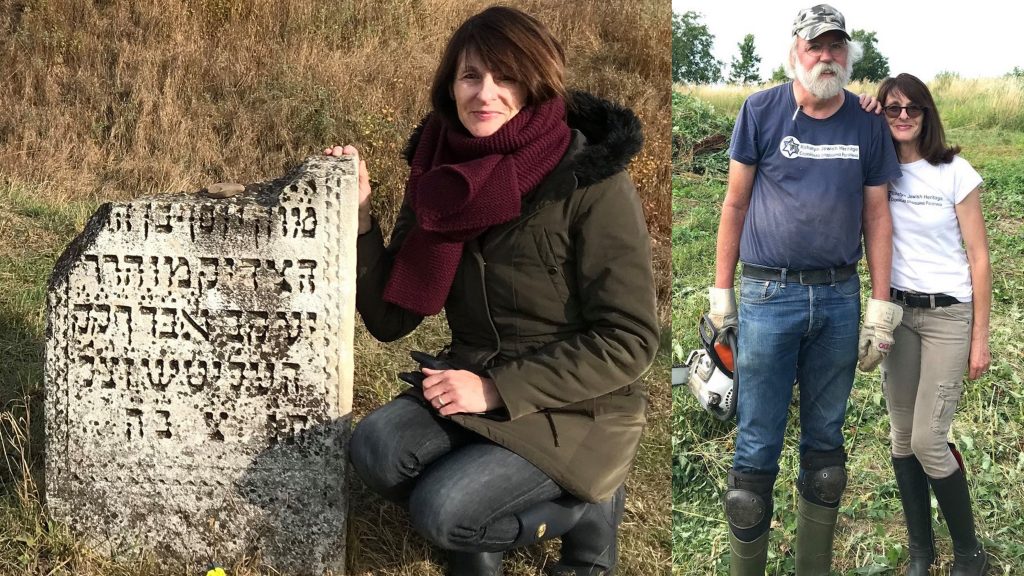
Marla Raucher Osborn and Jay Osborn are the founders of Rohatyn Jewish Heritage (RJH), a non-profit, non-governmental organization (NGO) that develops and manages heritage preservation projects aimed at reconnecting the 400-year history of Rohatyn's now-lost Jewish community with the people and places of the modern Ukrainian city. Since its inception in 2011, RJH has brought together a group of dedicated volunteers who have, among the organization's many efforts, maintained Rohatyn's four Jewish burial sites; recovered over 600 Jewish headstone fragments; researched and published local Jewish and Ukrainian histories; and jointly created a permanent exhibition on the Jewish community with Rohatyn's local history museum. Marla Raucher Osborn was a US Fulbright Research Scholar for the 2019-2020 academic year, conducting a research and demonstration project on Jewish heritage in western Ukraine that has been made public.
In March 2020, the Osborns traveled to California as the pandemic worsened in Ukraine. They plan to return to their home in Lviv, Ukraine later this year. Recently, I spoke with the Osborns via Zoom (their virtual backdrop was Rohatyn's 400-year-old Jewish cemetery) about how the pandemic has affected RJH and its work in Ukraine, whether heritage tours to and interest in western Ukraine are changing, and their plans for the future. The interview has been edited for length and clarity.
Natalia A Feduschak, UJE's Director of Communications
Natalia A. Feduschak: We are all navigating a new reality, and that is living with this virus while somehow continuing to do projects. How have you managed RJH being so far away from Ukraine?
Marla Raucher Osborn: We had just closed on several negotiations and projects [when the pandemic began]. We were, for example, already in talks with the city of Rohatyn about creating heritage signage and tourism brochures. Not being there to continue these conversations, we've had to rely a lot upon the NGO's Lviv attorney Wito [Nadaszkiewicz, Ed.]. The two biggest concerns I had when we came back to the U.S., was what was going to happen to the Jewish cemeteries and the mass graves in Rohatyn if we're not personally there to oversee and care for them? Having invested more than 10 years forging and nurturing local relationships in Rohatyn – with the administration, the church, students, teachers, librarians, residents, and others – this was very distressing. To our great pleasure and surprise, care for the heritage sites has so far been working out well, with us remotely managing issues as they arise and relying heavily upon Vasyl [Yuzyshyn, RJH team member, Ed.] as well as Ukrainian friends and activists in Lviv, many of whom helped us out in past years in Rohatyn. Some of these supporters have already reached out to help this year in our absence or have already started working, for example, this month and last alongside Vasyl at the cemeteries for their first clearings. 2021 has also so far seen interesting changes for the positive in Rohatyn on International Holocaust Remembrance Day back in January. Although we weren't there to work with, initiate, or encourage events to mark the date, Rohatyn students and educators, as well as the local history museum ("Opillya"), created their own – a first as far as I am aware! We would have, of course, loved to have been there, but we remotely watched many of these unfold on Facebook, including exhibitions (virtual and actual) at the museum and student talks and presentations in the classrooms. I was particularly touched by a group of students that went to Rohatyn's Jewish mass grave south of the town center and posted a photo of them solemnly standing around the memorial marker there. So, I now am feeling like maybe in some small way we have contributed to a new phase, a momentum if you will, that is local and organically driven in Rohatyn that doesn't require that we be there to make it happen. This is great, and we are obviously very pleased and encouraged about this.
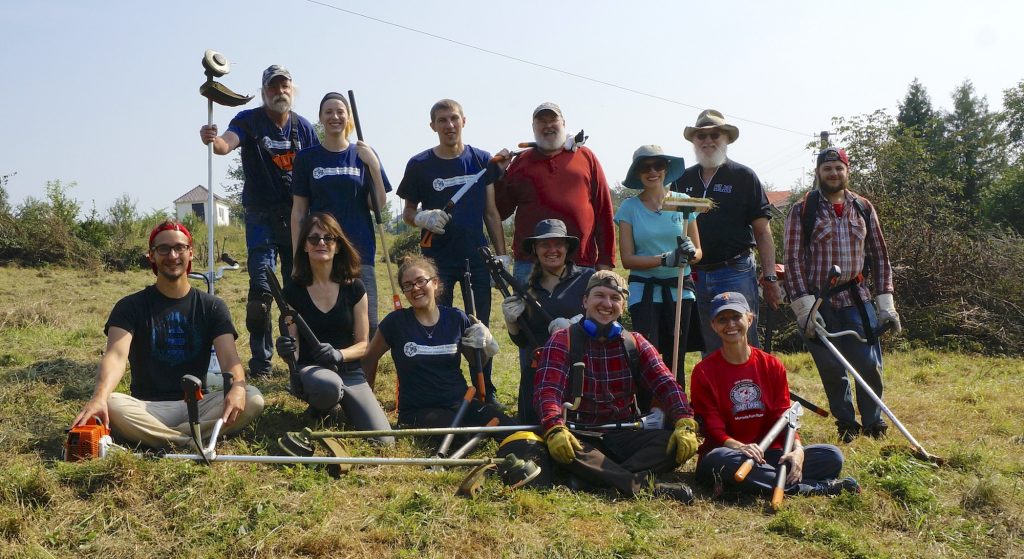
Natalia A. Feduschak: Why do you think this type of involvement is happening?
Marla Raucher Osborn: I sense there is something unique and really interesting happening right now in western Ukraine – something new that we have not seen before during our ten years working in the country. I'm not sure what or who initially inspired it, but I have seen, for example, on social media in a number of locations at the oblast [regional] level and at the city and village level, local administrators, boards, educators, and resident activists posting on social media about applications they have submitted this year or last for sponsorship-grants from the European Union for various projects, many of which go to promoting, enhancing, and funding heritage tourism and new projects of cultural preservation. A few months ago, for example, the public library in Rohatyn wrote us to support an application they were submitting for Holocaust resources and historical materials to add to their collection. Beginning at the end of 2020 and continuing into 2021, we also supported a Rohatyn high school student doing a research and writing project on Righteous individuals in Rohatyn who aided Jews during the war. We know that the Opillya museum was successfully awarded two European Union grants at the end of 2020 for projects coordinated with the city to promote heritage tourism through new pedestrian signage and brochures, which have already been partially realized as we speak: an important project to enhance knowledge of the city's heritage and its multicultural past, and one we very much support. So, without us even being present, nine new pedestrian signs went up in Rohatyn highlighting dozens of heritage sites in the city, including the Jewish cemeteries and mass graves, all bilingual (Ukrainian and English – great for residents and foreign tourists). There's a brochure now as well that maps these sites, which can be picked up at the Opillya museum. As I anticipated when the museum opened back in fall 2018, the museum is turning out to be a heritage and tourism starting point for anyone wanting to learn more about Rohatyn, past and present, Jewish and non-Jewish.
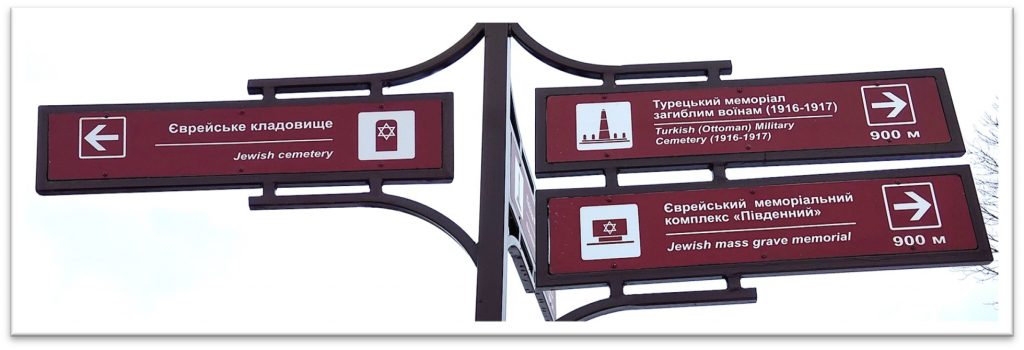
Natalia A. Feduschak: It's interesting because these are all Ukrainians, right? What does that say?
Marla Raucher Osborn: Interesting, yes! Again, I don't know exactly what inspired this recent interest in EU support for heritage and tourism, and why now, but it's not just happening in Rohatyn. I'm seeing similar efforts in other regions like Ternopil, Ivano-Frankivsk and Lviv. It's like suddenly somehow it came to the attention of the mayors and local radas [councils, Ed.] and activists in these places that the European Union, at least in western Ukraine, is looking to bridge, encourage and support cross-border exchanges and promotion of sites of cultural heritage. I believe 2021 would have been a bumper year for European tourists coming into western Ukraine had it not been for the pandemic. We were already seeing in the summer and fall of 2020 a noticeable rise of foreign visitors even in Rohatyn, especially Poles and Germans. So, timing for a post-pandemic return of tourists is perfect for these new projects. A number of cities and local museums in western Ukraine also appear to have recently boosted their online presence; I assume geared toward foreign visitors and cultural tourism. Personally, I believe that in the case of Rohatyn, the city's pro-EU progressive mayor, now in his second term, can be credited with at least some of what we are seeing in Rohatyn – surely he has been a significant force for these new heritage efforts in town, and he has brought to the office a strong civic pride element that we had not seen with the prior administration. Again, I'm seeing this new momentum and interest not just in Rohatyn but all across the three western Ukrainian oblasts.
Natalia A. Feduschak: Do you think there's a disconnect in terms of what Ukraine is and what people think it is, and the narrative about Ukraine outside its borders?
Marla Raucher Osborn: There's no question this disconnect exists, even today; we see it with Jewish descendants, western Europeans, Israelis, and others contemplating a visit to western Ukraine. I view one of my key roles on social media to highlight the common culture Ukrainians share with others and the spirit of civic activism that many young Ukrainians display with regard to their local communities and heritage. I am happy and humbled that this does not go unnoticed by Ukrainians, and many reach out to thank me for sharing my on-the-ground personal experiences with Ukrainians working to care for the Jewish heritage sites in their communities. Most are also very desirous of sharing their culture with Jewish descendants and others, and we (RJH) would very much like to help with that.
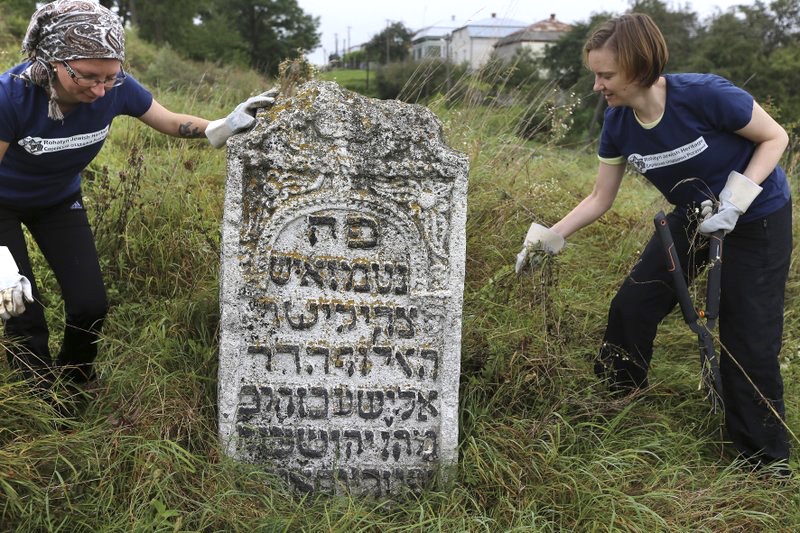
Jay Osborn: Here's a classic. We were in Warsaw. I can't remember the name of the woman who managed the main office for an international news agency in that region. She got her news feeds from a lot of different reporters in the region. But she didn't have any reporters in Ukraine. She had reporters in Poland, and she had reporters in Russia. She knows we're active in Ukraine on Jewish-Ukrainian relations and projects, and she wanted to talk to us. She was thinking about sending in a crew to do some filming in western Ukraine, and she had to assemble a team to do that. So, we talked about the logistics of some of this. Of course, we were very open to this; that kind of press gets international attention and is almost always very good for us and our projects in Rohatyn. And she said, 'OK, now what I want to talk about is Ukrainian antisemitism.' And we said, 'What?' I mean, there was no transition. And we said, 'Well, what do you mean?' And she says, 'Well, you know Ukrainians are known to be antisemitic, and you know, et cetera, et cetera.' And we said, 'Come on, stop this. Where are you getting your news, from Russia?' And she said 'Yes. Well, this information comes from our office in Moscow.'
Marla Raucher Osborn: She is the news source for Central Europe, which is supposed to include Poland and Ukraine. When I complained about this to another reporter, she jumped all over me. 'She's one of the best that they have,' and I'm thinking, 'You gotta be kidding.' Ukraine's got a real problem if this is the best of that news organization, and the first question she wants to ask in an interview with us is about Ukrainian antisemitism.
Jay Osborn: And that's only that one narrow topic. There are issues across the board.
Marla Raucher Osborn: There are. Another is my own misunderstanding about the multicultural presence today in families in Rohatyn, even if not immediately apparent. Previously I would often say that Rohatyn is today one hundred percent Ukrainian: no Jewish presence, no Polish presence, no cultural diversity. But that isn't really quite right, it turns out. The more I learn about and meet local people, the more I realize how blended current, modern Rohatyn families are. You have families that may have a Ukrainian surname, but the mother's maiden name suggests Polish family roots. Traditions present in the home (food, dress, holidays) often reveal these unseen roots. We even know of a couple of people today in Rohatyn who have (or believe they have) Jewish roots – and want me to know that! I suspect all across historical eastern Galicia this is true. The region is much more complex, much more blended and yet not obviously than I realized until recently.
Natalia A. Feduschak: How would you describe the Jewish community outside Rohatyn who travel to Ukraine and their perceptions of the country?
Jay Osborn: Marla always said when we were living in Poland that Jews in America, or Canada, or wherever in North America or elsewhere who had a dim view of Poland and the Poles in general, that if she could get them to come and spend the day with her, they would perhaps think differently. It's likely she could turn them around, at least open their eyes. It's absolutely the same for Ukraine. There is a whole range of attitudes and perceptions. It's almost all based on ignorance and the echoes of horrible stories. If you can actually get someone to come, the good news is if they're coming, that means they're at least open. Once they do come, usually, not always, but usually, those people can reach an arm out, shake hands with someone and recognize another person, and it goes from there. If people come with us, they usually can have a very enlightening experience: they see it's not just Jews taking care of Jewish spaces, it's the Ukrainian neighbors too. It's predominantly the local Ukrainians who have been the caretakers of these places for decades. We go from site to site around western Ukraine in our travels (and part of Marla's Fulbright research project), and we bump into people we know who live nearby, and we have conversations in Ukrainian. The Americans don't understand it, but we explain, or somebody translates for us. What's going on back and forth, they recognize OK, these are reasonable people.
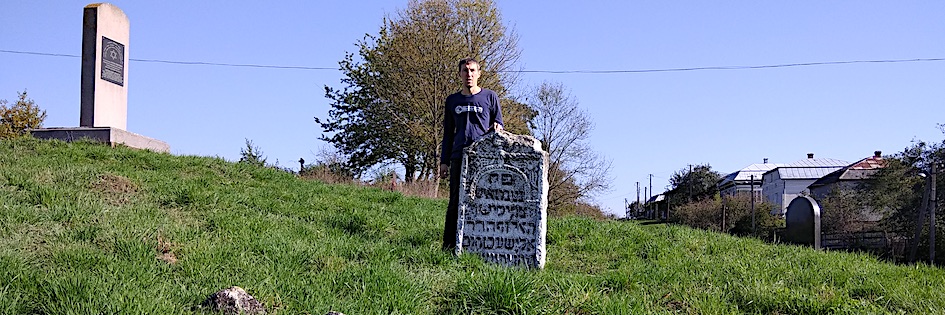
Natalia A. Feduschak: Do you find that these individuals end up being advocates for Ukraine after they return home? Because there are books published built on stereotypes of Ukrainians.
Marla Raucher Osborn: To quote a friend of ours, unless there can be resonance from family genealogy and heritage trips that help to advance Ukrainian-Jewish dialogue and heritage engagement by the diaspora, I'm not all that interested in getting involved. The benefits are not there for our projects in Rohatyn, and we are not tour guides or operators. Regrettably, yes, there are hundreds of books out there written by people who have made a single trip to Ukraine, usually "in the footsteps" of some ancestral story or family individual; but again, these are often based on a one-time, once-in-a-lifetime visit – and from that, they draw conclusions, accurate or inaccurate, which then become the new stereotype or reinforce old, outdated ones. Rarely have I read accounts that reflect the kind of in-depth and on-the-ground repetitive visits and relationships between visitors and local residents that can add nuance and update to the old stereotypes. We have had some visitors that come with us to Rohatyn, and they go home. As far as they're concerned, that was it. They've made their trip, and they're never going again. We usually never hear from them again either.
There are others that will go home and think about their trip a little bit, and they might even make a donation to Rohatyn Jewish Heritage, and that's it. And then there are those rare few who return and bring other family members. With them, there is a small positive resonance that we appreciate and encourage – an effort to try to reintroduce into the narrative of so many of our Jewish families that it is more than just death and destruction in Ukraine. If RJH can contribute a little bit to that perspective, then I consider our work with the Jewish diaspora a great success. These days, I feel compelled to highlight the many wonderful people – non-Jews – caring for the surviving Jewish heritage in their towns and villages, off the radar of the Jewish world. There are many of them, quietly running local projects: photographing Jewish headstones, cutting weeds and grasses at the Jewish cemetery, creating a temporary exhibition, speaking to students, making heritage tours.
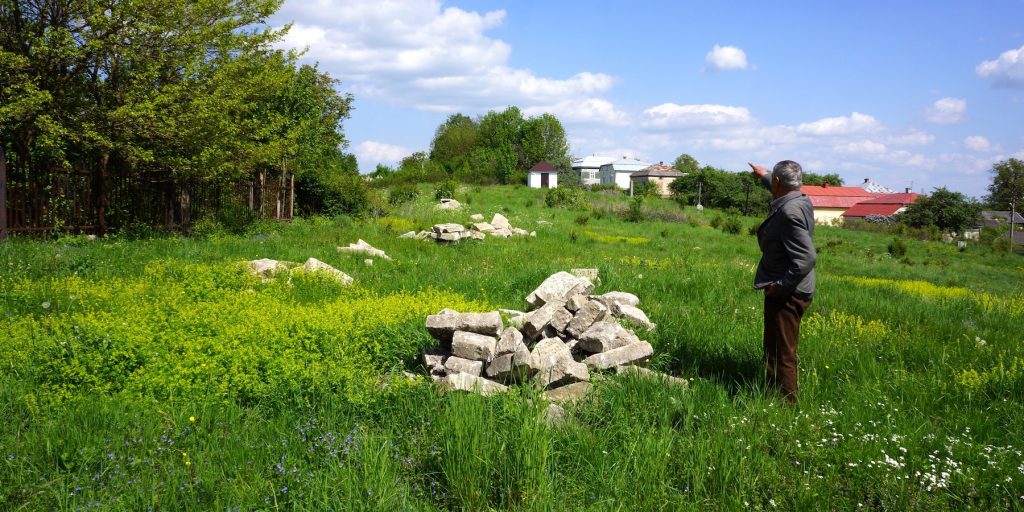
Natalia A. Feduschak: How do you change the narrative?
Marla Raucher Osborn: I think for some visitors, every little bit we can show them or say can make a difference. I also these days prefer (and often insist upon) only giving interviews if we can stand together in a Jewish cemetery, like those in Rohatyn that are devoid of headstones and appear as empty places. It is a whole different experience to be standing in a Jewish cemetery discussing issues of heritage preservation, involvement of the diaspora, Ukrainian caretakers, etc. I say, 'Come with me to Rohatyn and let's walk the streets and talk, and let's meet the people at the local history museum. And let's meet a couple of the students who worked with us in the cemeteries!' Again, I am looking for positive resonance when visitors and tourists return.
Natalia A. Feduschak: These are important sentiments. Do you hope a younger generation of Jews, and Ukrainians, will look at Ukraine and its past in a different way moving forward?
Marla Raucher Osborn: I'm not sure I'm in a position [to answer that]. Sometimes I feel less connected with the Jewish diaspora than I do with the local Ukrainian residents, in part because we have lived for so many years outside the U.S. In many ways, I feel more sensitive to the local concerns and causes. Facebook is a really good example. Last month I posted that May 14, 2021, is the day Ukraine recognizes the Righteous Among Nations: gentiles that helped or somehow aided Jews during the German occupation. I can't believe what I woke up to in the morning in some of the Jewish genealogy groups: so much anger! Few were responding, 'We should be honoring the memory of those that put everything at risk.' Many were saying, 'Who cares?' 'They're all antisemites!' This really, really saddened me. But I am not discouraged…at least yet.
Jay Osborn: I think it's important to say, though, that this kind of shallow understanding or very limited perception on the part of North American Jews, or Jews in general, toward Ukraine is really not much different from the North American view of any faraway culture… It's the typical inability for any small group to perceive realistically any other group, especially if they're at a distance. So I don't think this is special. And because of the Holocaust, there's a lot of agitation. It's like talking to Ukrainians in Rohatyn or elsewhere. The Holocaust was bad for Ukrainians also, of course. But nobody reserves as much heat for that as they do for the Soviet occupation. That's a big deal for Ukrainians, what the Soviets did. It's a similar kind of thing; could you have a discussion with Ukrainians about Russians? It's not easy. We've even been on Jewish heritage work camps with Jews from Russia who came to participate as volunteers. It's a little tricky because they're Russian, and Russian is their mother tongue. You know these are still good-hearted people.
Marla Raucher Osborn: I don't want to paint a totally bleak picture here. The last thing I want to do is put myself out there as a spokesperson for the Jewish diaspora. I am not a practicing Jew, and I am married to a non-Jew. But I would say one positive development that may resonate in the long run for the Jewish diaspora coming more [often to Ukraine, Ed.], is that the world of Jewish genealogy is making it easier to make these kinds of trips and in more meaningful ways. There are many organizations now that merge genealogy and heritage tourism. Examples include Taube, based in San Francisco but with a heavy presence in Poland and JewishGen. We have been seeing more family trips being organized by such professional groups that also want to include a volunteer day working at a foreign Jewish cemetery. I would love to see something like that happen in Ukraine. We had two visit groups come to Rohatyn in summer 2019: one from the Galicia Jewish Museum (Kraków, Poland) and one from Rootka in Lublin, a genealogy-heritage tour organization associated with Shtetl Routes. We didn't do any work together in the cemeteries, but it is the next logical step for summer 2020 had the pandemic not interfered. Maybe 2022?
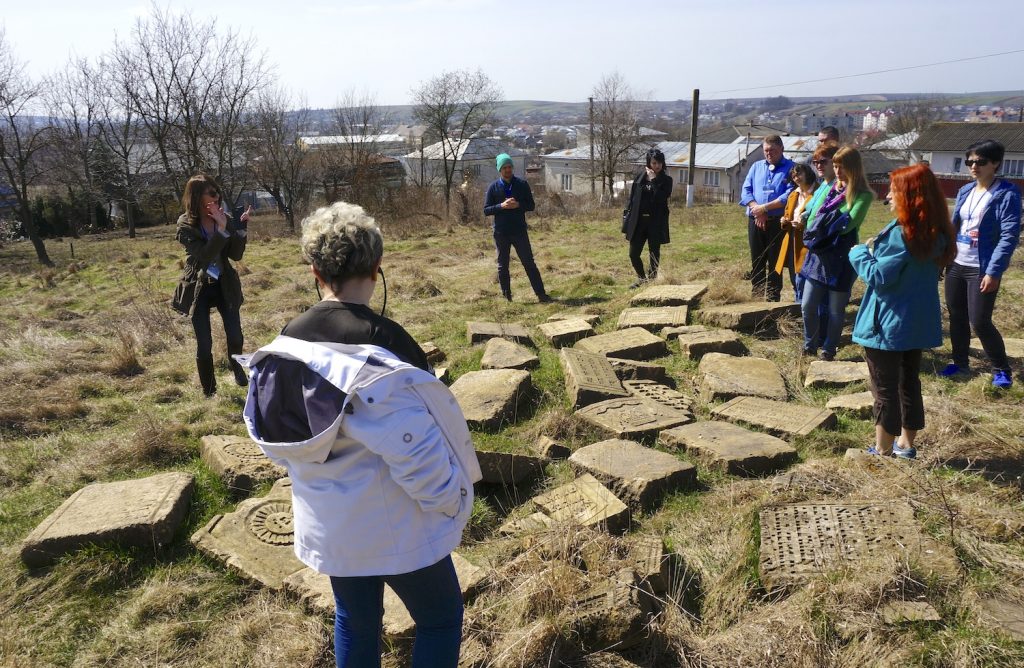
Natalia A. Feduschak: You manage the Rohatyn Jewish Heritage website and the website A Guide to Jewish Cemetery Preservation in Western Ukraine, which is the result of your Fulbright. Please tell us more about these sites and who the target audiences are for each.
Marla Raucher Osborn: These two websites really have different objectives and different audiences. The Rohatyn website really is directed towards anyone who traces their roots to the region, whether they're Jewish, Ukrainian, or Polish. Obviously, the website is heavily focusing on the Jewish history; I would very much love to have Ukrainians contribute to the Ukrainian history, which is largely unknown to Jews like me from Rohatyn. The website is bilingual in English and Ukrainian to make it useful to both groups: Jewish descendants and today's Ukrainian Rohatyners. As I mentioned earlier, a student in Rohatyn decided she wanted to do a paper on Ukrainian Righteous. Thanks to the Rohatyn Jewish Heritage website, I could send her to our page in Ukrainian dedicated to the Righteous of Rohatyn.
Jay Osborn: If I can cut in, what has been a driving motivation for us is to try to recover, reassemble, and present information that, especially, local people did not have access to about the last Jewish community of Rohatyn. At the same time, it's surprising how little Jewish descendants of Rohatyn know about the Jewish history of Rohatyn, their own history! It's been eye-opening for us as we've worked on it. The website can help with that.
Marla Raucher Osborn: And actually, it's been a little disappointing at times because it doesn't matter whether you're Jewish or not. Family stories become fact, even if they're not factually accurate! The website has, for example, a Holocaust timeline, extensively footnoted and referenced; the info is there for anyone wishing to dig deeper into the topic. No need to repeat bad data from generation to generation! With the hyperlinks to the sources, people can dig deeper; they have at least the inroads to do that. That's the Rohatyn Jewish Heritage website. The Fulbright website has what I consider to be an entirely different focus. And that focus really evolved as our work evolved. I want the website to be where it doesn't matter if you're Jewish or you're Ukrainian or whatever, but you're thinking, ' Good, I want to do something. I know behind my mother's house, or up the street from my grandmother, there is this Jewish cemetery, but there are no signs. There are no memorials. Nothing. And I don't even know where to begin. I wanted to be able to say to these people, 'Here's a page that tells you what it takes to start a website to talk about your project. Here's a page that talks about what tools are best for cleaning a cemetery or a headstone without damaging it. Here's a page of all the Jewish burial sites in the three oblasts of Lviv, Ternopil and Ivano-Frankivsk, with GPS and photos and descriptions.' No need anymore to ask me, 'Is there a cemetery in my western Ukrainian ancestral town?' I can now say, 'Look at the table. There are three of them. There are two mass graves with GPS coordinates.' No one can now say, 'I don't know where it is. I don't know where to begin.'
The website has more than 60 pages online in English at this point (and nearly an equal number in Ukrainian). Topics include how do you find volunteers, FAQs, ideas for raising awareness and interest among Jewish descendants, organizing local help, understanding surveying equipment, options for memorial designs and signage, and so much more! All this is what the Fulbright website is intended to do: make available ideas and concrete examples, both inside Ukraine and outside the country, for inspiring new projects and developing new activists.

Jay Osborn: The Fulbright website came out of our own need for information and best practices. Ten years ago, when we first were exposed to this, we didn't even know how to state the problem. We didn't have any idea about possible solutions. There would probably be more than one kind of solution. We had no idea. A couple of years after that, Marla went to a conference in Krakow that was talking about Jewish heritage in general. For the second time at a conference on this topic (our first), there was a broad general statement among all these academics and other kinds of people that there should be a best practices guide. A collection or manual or something about how to care for Jewish heritage. And we said, 'Yes, we could absolutely use that.' Two years later, there was a third conference on Jewish heritage, this time in Vilnius. At the end of it, there was a general agreement– lots of nodding heads – that there should be a best practices statement or guide of some sort. We said, 'Dammit.'
Natalia A. Feduschak: So I guess if you want to have something done, you just have to do it yourself.
Marla Raucher Osborn: Renovation and memorialization of Rohatyn's 400-year-old Jewish cemetery as an on-the-ground demonstration project was the inspiration for the Fulbright project: best practices in caring for this vulnerable Jewish historic space and designs for incorporating the hundreds of headstone fragments we have from walkways, roads, gardens, and dismantled walls and buildings in the city. The pandemic and our sudden departure in March 2020 temporarily delayed this part of the project. But even before we left Ukraine and after the Fulbright academic year began, we were traveling a lot in western Ukraine and realized a larger need that the project could address: those numerous and frequent questions I get via Facebook and email 'What's in my town today?' 'Is there a Jewish cemetery?' 'Are there any headstones still standing?' 'Is there a memorial to the destroyed Jewish community?' Before departing for the U.S., Jay and I managed to visit just over half the 525 plus Jewish burial sites (cemeteries and mass graves) identified in the three oblasts of Lviv, Ternopil and Ivano-Frankivsk. The Fulbright website has tables listing these with GPS coordinates (or close equivalent) and hyperlinks to other websites with photos and more information, including ESJF European Jewish Cemeteries Initiative (for cemeteries) and Yahad – In Unum (for mass graves) – our two key resources for this part of the Fulbright project. We very much look forward to resuming our travels to all these sites once we are home.
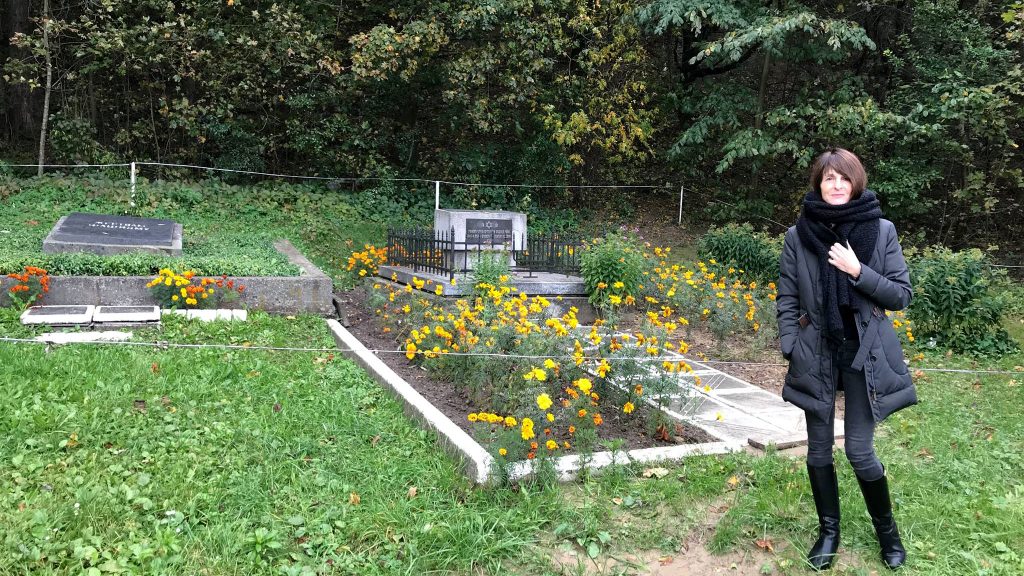
Jay Osborn: Just to see the sights and try to understand them, photograph them and so forth.
Marla Raucher Osborn: To photograph them, to try and get GPS coordinates. If we didn't have good GPS, we did the best we could on the ground, at the sites. So, along the way, the Fulbright project evolved and expanded from the Rohatyn old Jewish cemetery demonstration project and best practices, to mapping and documenting these so people interested in launching new preservation and memory projects could help themselves by consulting our tables. Both ESJF and Yahad are openly and heavily acknowledged on the Fulbright website, and we actively worked with them to accurately create the three tables. Both organizations have contact info there too. One thing the Fulbright website is not is a way to engage us to [start] a new project. The website is there to provide our ten years of experience in Rohatyn as a guide for others.
Natalia Feduschak: You are a registered Ukrainian NGO and its principal stakeholders. How do you divide the financial responsibilities between the organization and yourselves?
Jay Osborn: We made a decision about financial responsibilities for our heritage work in Rohatyn even before the NGO was formed. We had been collecting small donations from Jewish descendants for over 10 years in order to do project work there, which at the time was primarily collecting displaced Jewish headstone fragments and returning them to the cemeteries. We decided that no donations would go toward any of the administrative or overhead costs associated with the NGO. Marla and I put up our own money for those expenses. If somebody else donates because they want to help with cemetery care or something like that, that money goes 100% to cemetery care. All of the expense associated with fees and lawyer costs, banking costs and all that stuff, it all comes out of our pocket, and that includes our salaries working for the NGO (the basis for our Ukrainian residency). We make major purchases as an NGO there in Ukraine. A couple of years ago, we bought a lot of power tools and related things like gloves, hand tools, first aid, etc., for clearing the cemeteries. Rather than fund it up-front out of our pockets and get reimbursed from the NGO, which is the way we do all the small stuff, we had the NGO pay the tool company and suppliers directly.
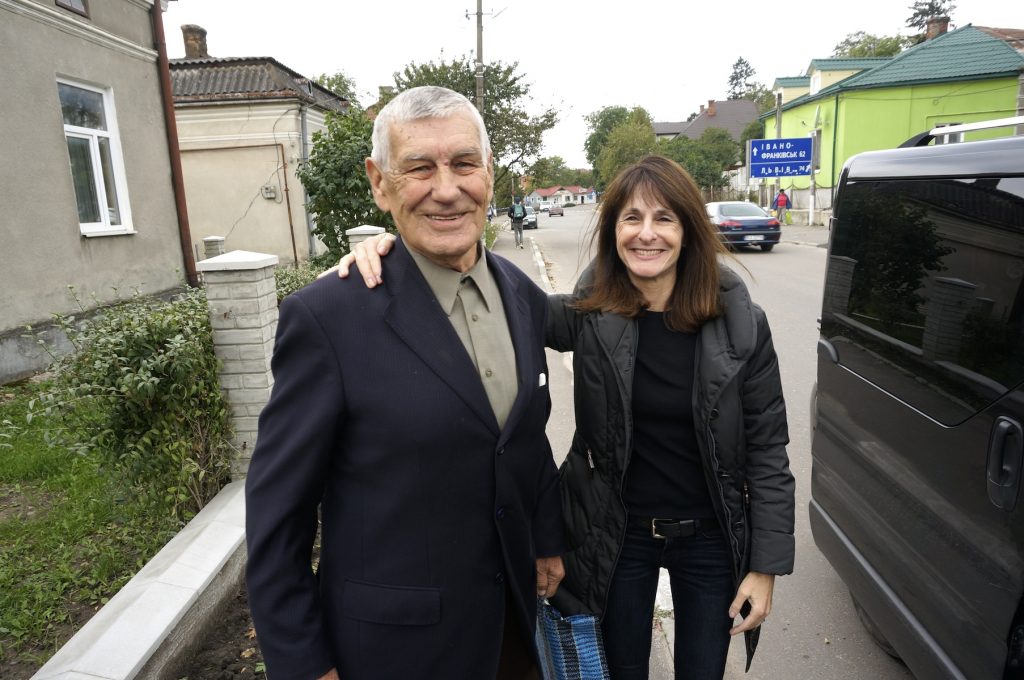
Natalia A. Feduschak: Where do you see yourselves five or 10 years from now? Do you see yourself doing the same thing or evolving into something else? Do you see yourselves in Ukraine?
Marla Raucher Osborn: We consider Lviv home. We are in Los Gatos, California, for now. This is temporary; this is not home. All our books, clothes, tools, etc., are still back in our apartment in Lviv. It will be quite the time capsule when we return later this year! I can't say where we will be in three to five years. I do feel encouraged based on what I've seen locally in Rohatyn on some of the topics we have talked about already; namely, that civic and heritage projects have been organically moving forward even in our absence. I feel very good about that, even if they are not specifically Jewish projects or our projects. Maybe it will be possible in a few years to transition into a more remote relationship with our partners and supporters in Rohatyn. Until recently, we have felt it necessary for us to be present and on the ground for our work and for our projects to advance. We've been delighted and encouraged by what we've seen happening while we have been away.
Jay Osborn: We can say we have started thinking about this question ourselves. We're not sure. We also have to be realistic. I just turned 64. We can do this sort of thing for a while, but for 10 more years, I kind of doubt it. We both feel building and sustaining relationships in order to do our work requires that we be both on the ground and face-to-face with people. Marla mentioned that a couple of times already. It's very real, and we have to figure out how to transition someday from that. But in the meantime, we need to continue to be on the ground, face-to-face with people in order to take what we're doing to the next level, get some stability and some permanence to it. Right now, it takes a huge amount of effort just to hold ground. We need to get it to a point where it takes less effort to hold ground, and we can build.
Marla Raucher Osborn: I would like to end on a positive note. Which is what I actually see as my role in the future, when we get back. I want to pick up on something that has already been started in western Ukraine and Rohatyn, and that is a general local sense of civic responsibility toward heritage. Regardless of what the heritage is. And I want to encourage that. As we get older, we are more focused on what it is going to take for us to "pass the baton" to the next generation of caregivers and activists in Rohatyn. Whether or not the Jewish diaspora gets more involved is almost irrelevant. I would like, of course, for them to be more involved, but in the bigger picture, this becomes something that needs to be sustained locally, and I think there are encouraging signs.



















